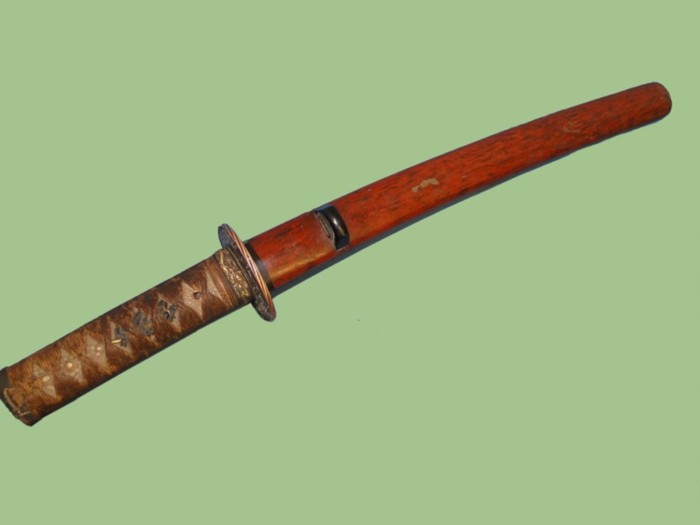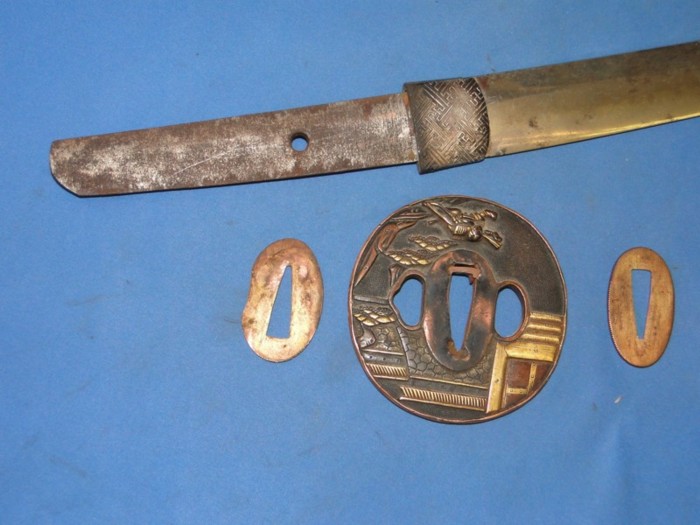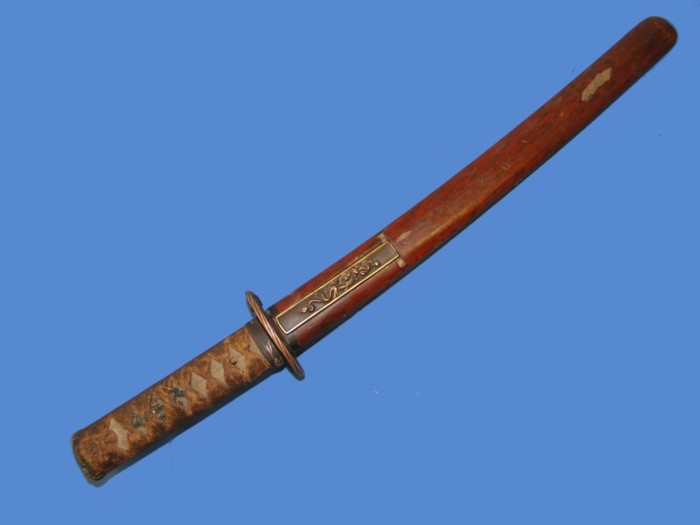WWII SAMURAI WAKISASHI SWORD 65 -
This is a Japanese sword whose blade dates back to the 1750's. The length of the blade is approximatelly
13 inches. Several polishes have been applied over the years. The present one was probably given around
the WWII period.

The handle is wrapped with a brown cloth. The backing consists of ray skin. A pair of high quality dragon
Menuki. The pommel cap and throat piece have matching dragon patterns. The one found on the pommel is
fully extended and shows deep pebbling on the surface. Very nice quality.


|
The Samurai sword has a very rich history. The sword has been manufactured for several centuries and continues
to be produced today. The sword represented more than just a weapon. It was the soul of the Samurai warrior.
When attempting to identify the type of sword you have It is important to keep in mind that the fittings of
a sword (scabbard, handle, crossguard. etc.) may be identical from one sword to another. The reason why is
because during WWII the same fittings were used in all Army swords, Navy swords, etc. Armed forces are all
about uniformity. They strive to make everything the same.
This is the reason why a sword cannot be identified merely by its external appearance.
Understanding the different components that make up the Samurai sword is the first step in figuring out the
type of sword you have. That is the reason why we have created the
Understanding the Samurai sword section as a means to
provide a novice with the basic knowledge to start the path of determining the questions everyone has;
who made the sword, how old it is nad how much it is worth.
|




The Habaki is silver foiled and has a square pattern applied to the surface. This is a single piece style.
The purpose of the Habaki is to hold the sword inside the scabbard when it is placed in. There was a
designated artisan whose task was to create this piece. The complexity of the design depended on how much
the customer wanted to pay.

Some of the swords were outfitted with a small utility knife. The scabbard had an opening to hold the knife.
In this case the handle of the knife is decorated with a dragon mottif to match the other decorations found
on the fittings of the sword.
The handle is made of brass. The reverse side has characters engraved in the pommel area. The length of the
knife is around 8 inches. The artisan who created the design did a really good job. When the knife is stowed
into the sheath it truly compliments the appearance of the sword. The fit is so good it almost looks like it
is a permanent fixture instead of being a removable knife.


|
This page is a recognition and identification guide for Samurai swords.
Multiple detailed photos of a specific sample are provided. Descriptions point
out clearly defined points that should be noted.
One of the most commonly asked questions is "How much is my Samurai Sword worth?".
A price guide is included here to address this question. The value of the swords is
reviewed over a period of several years. A trend can be observed. The present worth
of the edge weapons in the collector's market is illustrated.
This service is provided free of charge to the visitor/enthusiast courtesy of
MilitaryItems.com,
a company dedicated to the preservation of military history and to providing quality
military antiques and collectibles to museums, institutions and the general public.
|
|




The series of pictures above provide a very good show of how the sword and its components were decorated.
As discussed earlier the knife inserts into the side of the scbbard creating a seamless appearance. A feeling
of unquestionable belonging.








The Tsuba (cross guard) is a true piece of art. It displays a well executed motiff on both sides. The top displays
a Samurai warrior walking in front of a traditional Japanese castle. The construction has the opening for the blade
and two additional openings. A separate wedge has been added to the blade opening. This was a common
practice when re-fitting the Tsuba for a different blade.
The reverse side shows extensive pebbling with a tree branch on one end and a rock with plants on the other. A
Samurai figure is also in the picture.
The edge of the Tsuba has a rope-like contour. A very nice finishing touch.

The following photograph illustrates both sides of the handle. A dragon Menuki is found on both sides.
The wrapping remains strong. One ray backing has a large crack.

The skin of a ray has different size bumps. When selecting the ray skin to cover the handle special attention
was given to find the biggest bumps. They were placed near the pommel. This was a feature that increased the
cost of the order.


This Samurai Sword may be currently reproduced.
It is becoming more difficult to be able to tell the fake ones from the real ones because
the quality of the reproductions is improving. The collector must become familiarized with
the construction style and materials employed in the manufacturing of this item.
Attention to the details is critical in order to be able to determine the authenticity of
the collectible.
If you have an interest is seeing other Japanese Samurai swords, you can do so by going to our
Japanese Samurai Swords Price Guide
identification guide. Where we cover Samurai swords from all periods.
| 




